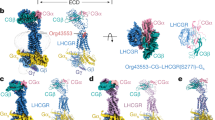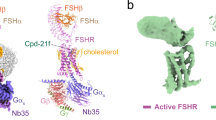Abstract
Follicle-stimulating hormone (FSH) is produced and secreted in multiple molecular forms. These isoforms differ in their oligosaccharide structures, which determine the particular behavior of a given variant in in vitro and in vivo systems. Employing heterologous cell assay systems, this and other laboratories have shown that highly sialylated human FSH variants exhibit lower receptor binding/immunoactivity as well as in vitro bioactivity/immunoactivity relationships than their less sialylated counterparts. It is not known, however, whether this characteristics behavior of the FSH isoforms is reproduced by homologous assay systems, in which unique variants of the receptor are presumptively expressed. To gain further insights into the structure–activity relationship of the various FSH isoforms, we analyzed the capacity of nine charge isoforms obtained after high-resolution chromatofocusing (pH window, 7.10 to <3.80) of anterior pituitary glycoprotein extracts to bind and activate their cognate receptor expressed by naturally occurring heterologous cell systems (rat granulosa cells and seminiferous tubule homogenates) as well as by human embryonic kidneyderived 293 (HEK-293) cells transfected with the human FSH (FSH-R) receptor cDNA. In both (heterologous and homologous) receptor assay systems, the isoforms displaced 125I-labeled FSH from the receptor in a dose-response manner; however, whereas in the heterologous systems, the receptor binding activity varied according to the elution pH value/sialic content of the isoforms, with the less acidic variants exhibiting higher receptor binding activity (r=0.851 and 0.495 [p<0.01 and p<0.05] for the granulosa cell and testicular homogenate receptor assay systems, respectively) than the more acidic/sialylated analogs, in the homologous assay, this relationship was practically absent (r=0.372, p N.S.). The capacity of the isoforms to induce androgen aromatization by rat granulosa cells followed the same trend shown by its corresponding receptor assay system (r=0.864, p<0.01). Interestingly and in contrast to the results observed in the homologous receptor binding assay, the ability of the isoforms to induce cAMP production by HEK-293 cells varied according to their elution pH value, with the more sialylated isoforms exhibiting lower potency than their less acidic counterparts (r=0.852, p<0.01). The results yielded by the heterologous assays suggest that the different potency of the isoforms to elicit abilogical effect in a naturally occurring receptor system depends primarily on the particular affinity of the receptor molecule for each isoform. The existence of a clear dissociation between receptor binding and signal transduction in the homologous system indicate that this later function is rather related to the different ability of the FSH glycosylation variants to induce and/or stabilize distinct receptor conformations that may permit preferential or different degrees of activation/ inhibition of a given signal transduction pathway. Thus, the human FSH receptor-transducer system apparently possesses sufficient versatility to respond in a different manner to glycosylation-dependent diverse FSH signals.
Similar content being viewed by others
References
Pierce, J. G. and Parsons, T. F. (1981). Annu. Rev. Biochem. 50, 465–495.
Gharib, S. D., Wierman, M. E., Shupnik, M. A., and Chin, W. W. (1990), Endocr. Rev. 11, 177–199.
Sairam, M. R. (1989), FASEB J. 3, 1915–1026.
Wilson, C. A., Leigh, A. J., and Chapman, A. J. (1990). J. Endocr. 125, 3–14.
Ulloa-Aguirre, A., Midgely, A. R., Jr., Beitins, I. Z. and Padmanabhan V. (1995), Endocr. Rev. 16, 765–787.
Chappel, S. C., Coutifaris, C., and Jacobs, S. C. (1982) Endocrinology 110, 847–854.
Ullo-Aguirre, A., Mejía, J. J., Domínguez, R. Guevara-Aguirre, J., Díaz-Sánchez, V., and Larrea, F. (1986), J. Endocrinol. 110, 539–549.
Ulloa-Aguirre, A., Espinoza, R., Damián-Matsumura, P., Larrea, F., Flores, A., Morales, L., et al. (1988), Biol. Reprod. 38, 70–78.
Ulloa-Aguirre, A., Cravioto, A., Damián-Matsumura, P., Jiménez, M., Zambrano, E., and Díaz-Sánchez, V. (1992). Hum. Reprod. 7, 23–30.
Stanton, P. G., Robertson, D. M., Burgon, P. G., Schmauk-White, B., and Hearn, M. T. W. (1992), Endocrinology 130, 2820–2832.
Simoni, M., Jockenhovel, F., and Nieschlag, E. (1994), J. Endocrinol. 141, 359–367.
Padmanabhan, V., Lang, L. L., Sonstein, J., Kelch, R. P., and Beitins, I. (1988), J. Clin. Endocrinol. Metab. 67, 465–473.
Ulloa-Aguirre, A., Damián-Matsumura, P., Espinoza, R., Domínguez, R., Morales, L., and Flores, A. (1990), J. Endocrinol. 126, 323–332.
Wide, L., and Bakos, O. (1993), J. Clin. Endocrinol. Metab. 76, 885–889.
Zambrano, E., Olivares, A., Méndez, J. P., Guerrero, L., Díaz-Cueto, L., Veldhuis, J. D., et al. (1995), J. Clin. Endocrinol. Metab. 80, 1647–1656.
Ulloa-Aguirre, A., Miller, C., Hyland, L., and Chappel, S. C. (1984), Biol. Reprod. 30, 382–387.
Wide, L. and Hobson, B. M. (1986), Acta Endocrinol. (Copen.) 113, 17–22.
Cerpa-Poljak, A., Bishop, L. A., Hort, Y. J., Chin, C. K. H., DeKroon, R., Mahler, S. M., et al., (1993), Endocrinology 132, 351–356.
Flack, M. R., Bennet, A. P., Froehlich, J., Anasti, J. N., and Nisula, B. (1994), J. Clin. Endocrinol. Metab. 79, 756–760.
Mulders, J. W. M., Derksen, M., Swolfs, A., and Maris, F. (1997), Biologicals 25, 269–281.
Timossi, C., Damián-Matsumura, P., Domínguez-González, A., and Ulloa-Aguirre, A. (1998), Mol. Hum. Reprod. 4, 1032–1038.
Liu, L., Southers, J. L., Banks, S. M., Blithe, D. L., Wehmann, R. E., Brown, J. H., et al. (1989), Endocrinology 124, 175–180.
Dias, J. A., Lindau-Shepard, B., Hauer, Ch., and Auger, I. (1998), Biol. Reprod. 58, 1331–1336.
Yarney, T. A., Jiang, L., Khan, H., MacDonald, E. A., Laird, D. W., and Sairam, M. R. (1997), Mol. Reprod. Dev. 48, 458–470.
Sairam, M. R., Jiang, L. G., Yarney, T. A., and Khan, H. (1997), Mol. Reprod. Dev. 48, 471–479.
Sairam, M. R., Jiang, L. G., Yarney, T. A., Khan, H., Jayashree, G. N., and Babu, P. S. (1998). Program and Abstracts of the 80th Annual Meeting of the Endocrine Society (USA), New Orleans, LA, p. 63, Abs. OR8-4.
Baenziger, J. U. and Green, E. D. (1988), Biochim. Biophys. Acta 947, 287–306.
Stanton, P. G., Burgon, P. G., Hearn, M. T. W., and Robertson, D. M. (1996), Mol. Cell. Endocrinol. 125, 133–141.
Robertson, W. R., Lambert, A., Mitchell, R., and Talbot, J. A., (1997). In: FSH Action and Intraovarian Regulation. Fauser, B. C. J. M. (ed.), Parthenon: London, pp. 33–50.
Zambrano, E., Barrios-de-Tomasi, J., Cárdenas, M., and Ulloa-Aguirre, A. (1996), Mol. Hum. Reprod. 2, 563–571.
Jarvin, D. L. and Finn, E. E. (1995), Virology 212, 500–501.
Roth, K. E. and Dias, J. A. (1995), Mol. Cells. Endocrinol. 109, 143–149.
Hattori, M., Ozawa, K., and Wakabayashi, K. (1985), Biochem. Biophys. Res. Commun. 127, 501–508.
Mulder, J. E., Schneyer, A. L., Taylor, A. E., Crowley, W. F., and Sluss, P. M. (1994), Endocr. J. 2, 25–31.
Ulloa-Aguirre, A. and Timossi, C. (1998), Hum. Reprod. Update 4, 260–283.
Timossi, C., Barrios-de-Tomasi, G., Zambrano, E., and Ulloa-Aguirre, A. (1998), Neuroendocrinology 67, 153–163.
Tilly, J. L., Aihara, T., Nishimori, K., Jia, X. C., Billing, H., Kowalski, E., et al. (1992), Endocrinology 131, 799–806.
Schaaf, L., Leiprecht, A., Saji, M., Hübner, U., Usadel, K. H., and Khon, L. D. (1997), Mol. Cell. Endocrinol. 132, 185–194.
Persani, L., Borgato, S., Romoli, R., Asteria, C., Pizzocaro, A., and Beck-Peccoz, P. (1998), J. Clin. Endocrinol. Metab. 83, 2486–2492.
Bex, F. J. and Corbin, A. (1981), Endocrinology 108, 273–280.
Dufau, M. L., Tsurahara, T., and Catt, K. J. (1972), Biochem. Biophys. Acta 278, 281–292.
Chappel, SC, Bashey, H. M., and Snyder, P. J. (1986), Acta Endocrinol. (Copenth.) 113, 311–316.
Jia, X. Ch. and Hsueh, A. J. W. (1985), Neuroendocrinol. 41, 445–448.
Guevara-Aguirre, J., Schoener, G., Ulloa-Aguirre, A., Pérez-Palacios, G., and Larrea, F. (1986), Int. J. Androl. 9, 381–392.
DeLean, A. P., Munson, P. J. and Rodbard, D. (1978), Am. J. Physiol. 235, E97-E102.
Author information
Authors and Affiliations
Corresponding author
Rights and permissions
About this article
Cite this article
Zambrano, E., Zariñán, T., Olivares, A. et al. Receptor binding activity and in vitro biological activity of the human FSH charge isoforms as disclosed by heterologous and homologous assay systems. Endocr 10, 113–121 (1999). https://doi.org/10.1385/ENDO:10:2:113
Received:
Revised:
Accepted:
Issue Date:
DOI: https://doi.org/10.1385/ENDO:10:2:113




